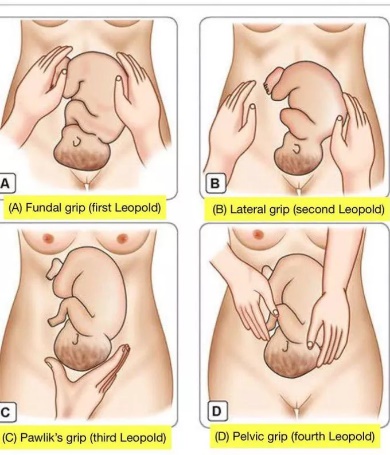A nurse in a prenatal clinic is caring for a client. Using Leopold's maneuvers, the nurse palpates a round, firm, movable part in the fundus of the uterus and a long smooth surface on the client's right side. In which abdominal quadrant should the nurse expect to auscultate fetal heart tones?
Left lower
Right upper
Right lower
Left upper
The Correct Answer is B
Choice A reason:
The left lower quadrant is not typically where fetal heart tones are auscultated when the round, firm part of the fetus (usually the head) is palpated in the fundus and the long smooth surface (indicative of the back) is on the right side. Fetal heart tones are best heard through the back of the fetus, and in this position, the back is not located in the left lower quadrant.
Choice B reason:
The right upper quadrant is the correct location to auscultate fetal heart tones in this scenario. The Leopold's maneuvers suggest that the fetus is in a cephalic presentation with its back facing the right side of the mother's abdomen. Therefore, the fetal heart tones are most likely to be heard in the right upper quadrant, just below the level of the fundus.
Choice C reason:
The right lower quadrant is generally not the area to auscultate fetal heart tones if the fetus's back is on the right side and the head is in the fundus. The heart tones are typically higher up and closer to where the back is palpated.
Choice D reason:
The left upper quadrant would not be the correct place to find fetal heart tones given the described position of the fetus. With the back on the right side, auscultation on the left would not yield the clear heart tones expected.

Nursing Test Bank
Naxlex Comprehensive Predictor Exams
Related Questions
Correct Answer is D
Explanation
Choice a reason:
Monitoring the heart rate is important for any newborn, but it is not the priority intervention for an SGA newborn. SGA newborns are at risk for several complications, but abnormal heart rates are not a primary concern directly related to being small for gestational age.
Choice b reason:
While monitoring weight is a part of routine newborn care and important for tracking growth and development, it is not the most immediate concern for an SGA newborn. The priority is to address potential acute complications that can arise from being small for gestational age.
Choice c reason:
Monitoring axillary temperature is important for maintaining normothermia in newborns, especially those who are SGA, as they have less subcutaneous fat and are more prone to heat loss. However, the most critical and immediate risk for SGA newborns is hypoglycemia, making blood glucose monitoring a higher priority.
Choice d reason:
SGA newborns are at increased risk for hypoglycemia due to their decreased glycogen stores. Therefore, monitoring blood glucose levels is a priority intervention. Hypoglycemia can lead to serious complications such as seizures and brain injury if not promptly identified and treated. It is essential to monitor blood glucose levels frequently and intervene as necessary to maintain them within a normal range.
Correct Answer is D
Explanation
The correct answer is choice D: Document the findings and continue to monitor the client.
Rationale:
Choice A: While encouraging the client to empty her bladder is important to help with uterine contraction, it's not the priority in this situation. The client's fundus is firm and midline, indicating good uterine contraction.
Choice B: Increasing the frequency of fundal massage is not necessary when the fundus is firm and midline. Excessive fundal massage can lead to uterine fatigue and decreased contractility.
Choice C: Notifying the client's provider is not necessary for a moderate amount of lochia rubra and small clots in the early postpartum period. This is a normal finding.
Choice D: Documenting the findings and continuing to monitor the client is the correct action. The nurse should document the amount, color, and consistency of lochia, as well as the fundus assessment. The client should be monitored closely for any signs of excessive bleeding or uterine atony.
Whether you are a student looking to ace your exams or a practicing nurse seeking to enhance your expertise , our nursing education contents will empower you with the confidence and competence to make a difference in the lives of patients and become a respected leader in the healthcare field.
Visit Naxlex, invest in your future and unlock endless possibilities with our unparalleled nursing education contents today
Report Wrong Answer on the Current Question
Do you disagree with the answer? If yes, what is your expected answer? Explain.
Kindly be descriptive with the issue you are facing.
